

Edition 115 - March 2018
Published at Quepos, Province of Puntarenas, Costa Rica
Publisher: GGC Publications Group
Editor: Bob Normand, The Golden Gringo, aka "GG"
(©Copyright 2008-2018 All Rights Reserved)
"The mission and goal of the Golden Gringo Chronicles is to provide,
in an
informative and entertaining way, insight into
living
the
Costa Rican
experience as an expat."
1. Broken News: Futbol News (Navas' Real Salary); Banking Scam; Costa Rica Wins Territory Award Against Nicaragua, First Round Election Results, Lifetime Cultural Achievement Awards, Costa Rica Workweek Second Longest in World
2. Rumble and Weather Talk: Little Rumble and Weather Problems; Some Cartoons and Jokes About Florida Hurricane Weather
3. Feature: Tropical Storm NATE in the Mountains (Recovering from the Tormenta)
4. ¿Que Es Eso? Department: Is it an Errant Moonscape or Something Else?
5. Feature: Golden Gringo University: Understanding Costa Rican Culture (Part 2: Language and Education, Money and Banking, Names and Surnames, Addresses and Street Names)
6. Health Stuff: Record tumor removal.
7. What's-in-a-Word: Answer to Que Es Eso, Etymology of Alvarado
8. ROMEO Corner: Sakura Fusion, Manuel Antonio
Wisdom of the Ages
|
Futbol News
 |
| Keylor Navas in Action |
Navas' Real Salary. Another football fan brought to my attention that I was behind the times with regard to what Team Real Madrid was paying Costa Rica's son and favorite futbol player, Keylor Navas. I quoted $1,000,000 per year which was his salary when he was first hired by RM in 2014 after the last World Cup games. The fan provided published information that shows Navas' current salary in English pounds is £85,000 per week. That means that Keylor's annual salary is (about) £85,000 x 1.42 x 52 = $6,276,400 per year. I guess he already got the increase I was sure he'd get because of his recent performances and awards.
 |
| Cristiano Rinaldo Describing The Size of His Bank Account |
Even at that level, Navas is far from the best paid futbol player, even on his own team. Published Forbes information says he ranks, at $6.3 mil/year only #17 on the Real Madrid team! There's mucho dinero in futbol amigos.
Number one paid RM dude is Cristiano Rinaldo, a Portuguese amigo whose salary is £365,000 per week. If I've got that number right, it's about $27 million annually. Not only that, it's after tax as his contract requires the team to pay taxes on his salary (in Spain where his salary is based the tax at that income level would be 52%)!
Add in his bonus and Cris knocked down $58 million in salary+bonus. Cris also pulled down $36 million in endorsements from the likes of Nike, Tag Heuer, Herbalife, Clear (men’s hair products), PokerStars, Nubia, XTrade, Sacoor Brother, Pestana hotels, and "his CR7-branded line of underwear, shirts, shoes, and namesake fragrance". Gee, it must be nice to have a namesake fragrance.
I believe that makes Rinaldo's total remuneration close to $94 million for 2017 and ranks him as the best compensated professional sports player in the entire world, just above Lebron James. It's quite possible he might become the first professional player to knock down $1 billion in his career as he expects to play for another eight years.
At least that's the info I have currently, but keep me straight all you rabid fans and amigos.
"Hello, my name is Antonio Lopez with Banco de Costa Rica; we need your help in changing your account number to permit easier transfers from the U.S. to your BCR account". So began a telephone scam on January 19th that old GG fell for hook, line and empanada.
 Three separate conversations over the next two days ensued in which I thought I was cooperating with the bank to improve their processes. Antonio Lopez (I'm sure that was not even close to his real name) was sly and smooth and exhibited just enough Spanish accent in his good English to make me feel comfortable enough to believe he could be from BCR. Somewhere in the second conversation I gave him my password (oops) "so he could change the account number". A couple of sentences later I said: "You shouldn't be asking for passwords..." and he deftly brushed that off.
Three separate conversations over the next two days ensued in which I thought I was cooperating with the bank to improve their processes. Antonio Lopez (I'm sure that was not even close to his real name) was sly and smooth and exhibited just enough Spanish accent in his good English to make me feel comfortable enough to believe he could be from BCR. Somewhere in the second conversation I gave him my password (oops) "so he could change the account number". A couple of sentences later I said: "You shouldn't be asking for passwords..." and he deftly brushed that off.
I had $830 in the account on Friday the 19th and was about to pay rent and electricity on Monday but when I went to do so the account had been emptied down to $7. I immediately went to the bank branch in Quepos and reported the theft but to no avail as they felt little compulsion to replace the funds since I had given Antonio my password. Fortunately I had reserves in another account which I used to pay my bills.
I also went to the O.I.J. (Costa Rica version of the FBI) and filed a report which I believe is going to be cataloged, archived and remain undisturbed for time immemorial. A couple of weeks later, on February 7, I got another email from (the real) BCR saying I should take my OIJ report to the branch, which I did and spent an hour and fifteen minutes while the customer service lady generated yet another report, this one a two page form with one pertinent paragraph. I signed it, she signed and stamped it and that made it official that the money was officially lost.
This was an expensive lesson that GG should have been aware of preventing. It's particularly embarrassing to me because I had been a branch manager for a major bank in the States for several years and should have known better. Recently I've read and heard reports of similar scams on accounts belonging to other Costa Rica expats with even worse results, some totaling thousands of dollars. My charge to both the OIJ and BCR as I left them was "¡Attrape los landrones!" (Catch the thieves!). They smiled, I winced, we'll see.
Never, never, never give someone your personal information over the telephone and you won't have to learn the hard way like GG did.
Costa Rica Wins Judgment Against Nicaragua
You may recall that in 2010 Nicaragua took over a piece of Costa Rican territory in the northeast corner of the country (see INVASION). Costa Rica has been pursuing a claim for environmental damages and aggression on their territory ever since.
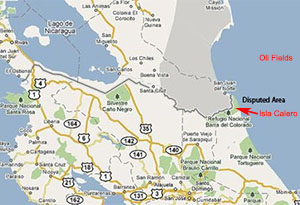 Finally, this past month, the ICJ (International Court of Justice - a U.N. organization) ruled in favor of Costa Rica, stating: 1). The only territory that belongs to Nicaragua in this area is the Portillos Lake and the coastline that separates it from the ocean, 2) Nicaragua established a military camp in Costa Rican territory, violating the country’s sovereignty and 3) Nicaragua is ordered, immediately, to remove their military camp from the beach of Isla Calero.
Finally, this past month, the ICJ (International Court of Justice - a U.N. organization) ruled in favor of Costa Rica, stating: 1). The only territory that belongs to Nicaragua in this area is the Portillos Lake and the coastline that separates it from the ocean, 2) Nicaragua established a military camp in Costa Rican territory, violating the country’s sovereignty and 3) Nicaragua is ordered, immediately, to remove their military camp from the beach of Isla Calero.
In addition, the court ordered Nicaragua to pay Costa Rica about $379,000 for environmental damages which, according to some reports, is about twice what Nicaragua expected to pay and which was immediately termed by the Ticos as "inadequate". The court also confirmed Costa Rican ownership of some 10,000 square kilometers (about 3,900 square miles) of disputed Caribbean oil fields that Nicaragua previously had also said was Nicaraguan territory.
This is an unmitigated win for Costa Rica but don't count your turtles before they hatch as Mr. Daniel Ortega, the President (for life) of Nicaragua, has said several times that he would ignore the ICJ ruling, saying they have no jurisdiction here. We'll continue to follow what develops on this story.
Update: Maybe Sr. Ortega wasn't simply blowing smoke. By late February a picture appeared in the press showing that Nicaragua had removed their military outpost from the disputed area as demanded by the International Court. Now about those reparations Danny...
The first round of the quadrennial national general elections in Costa Rica went off again, peaceably as usual, on February 4. Two of the candidates out of a field of 13 presidential hopefuls emerged to participate in a runoff. Neither of them obtained the minimum 40% of the vote needed to win the contest outright (one got 24.9% of the vote and the other 21.7%). The runoff will happen on April 1 which happens also to be Easter.
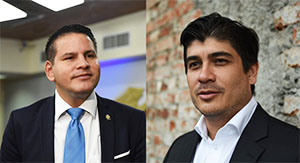 |
| Señores Fabricio Alvarado and Carlos Alvarado |
An interesting aside in this contest is that the two remaining candidates both share the same family last name, Alvarado. (See the etymology of this name in the What's-in-a-Word section below). The two are in no way related but one thing we can say for sure: the next president of Costa Rica will be Señor Alvarado. Another thing we can say is he'll be young; Fabricio is 43 (and got 24.9% of the vote) and Carlos is 38 (21.7% of the vote). There the easy comparisons end; after that the differences are substantial.
Fabricio is a well know journalist, evangelical preacher and Christian singer who rose from 3% to 26% in the presidential polls in the month of January alone. That was just after the Inter-American Court of Human Rights, a part of the OAS (Organization of American States), and interestingly enough based in our capital San José, issued a proclamation stating that Costa Rica should allow same-sex marriage. Fabricio immediately issued a statement that the ruling was a "sovereign violation" and as President he would seek to withdraw from the court if necessary. He struck a chord with many Costa Ricans and his poll numbers shot up dramatically.
Fabricio's party is called the National Restoration Party (Partido Restauración Nacional or PRN) while Carlos' party is the Citizens Action Party (Partido Acción Ciudadana or PAC). The PLN (Liberation Party) candidate, Antonio Alvarez, came in third with 18.7% of the vote and was disqualified from the runoff but the regions where his party was popular (my guess is that would be the Central Valley including San José) still ended up being strong enough to give his party the largest block in the legislature (17).
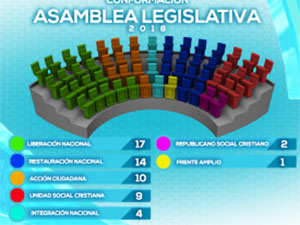 This election saw all 57 deputies elected to the unicameral legislature. They are elected by what is called "proportional representation" and do not require any type of runoff. Basically the number of deputies (57) are apportioned to the seven provinces according to population and then further proportioned to the parties by the percentage of votes that the party gets in a province. The results came in this way: PLN - 17; PRN (Fabricio) - 14 ; PAC (Carlos) - 10; PUSC (The Social Christian Unity Party) - 9 and three others with a total of 7 votes.
This election saw all 57 deputies elected to the unicameral legislature. They are elected by what is called "proportional representation" and do not require any type of runoff. Basically the number of deputies (57) are apportioned to the seven provinces according to population and then further proportioned to the parties by the percentage of votes that the party gets in a province. The results came in this way: PLN - 17; PRN (Fabricio) - 14 ; PAC (Carlos) - 10; PUSC (The Social Christian Unity Party) - 9 and three others with a total of 7 votes.
The battle is shaping up to be Christian right (Fabricio and PRN) and those who are against gay marriage vs pro-gay marriage (Carlos and PAC). Either outcome of the runoff will require coalition building in order for the president in power to have a majority (29) in the legislature so that he can pass the legislation he wants.
Now that GG has made Costa Rican politics perfectly clear....
World Justice Project
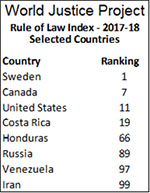 The World Justice Project is a non-profit independent organization based in Washington D.C. that studies and ranks countries for their "Rule of Law", basically an index of strength as a democracy and degree of open government.
The World Justice Project is a non-profit independent organization based in Washington D.C. that studies and ranks countries for their "Rule of Law", basically an index of strength as a democracy and degree of open government.
The eight factors that are used to measure this are: Constraints on Government Powers, Absence of Corruption, Open Government, Fundamental Rights, Order and Security, Regulatory Enforcement, Civil Justice and Criminal Justice. The table to the left provides the 2017-2018 ranking for selected countries that make up part of the total list of 113 countries around the world.
To investigate all the data and the WJP go HERE.
Lifetime Cultural Achievement Awards
A series of lifetime achievement awards were recently presented to a select trio of artists and musicians.
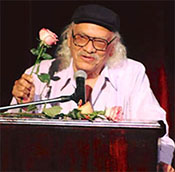 |
| José León Sánchez |
Among those receiving an award was José León Sánchez, probably the most prolific author in Costa Rican history. This gentlemen, now in his 80's, was unfairly found guilty of a major crime and sentenced at a young age to one of the most infamous penitentiary islands in Costa Rican history, Isla San Lucas, now long closed and made into a national historic site.
While imprisoned, León learned to write from other prisoners and practiced his writing by penning letters for other prisoners. Later, after he was released he wrote a book about life on the island called "La Isla de Los Hombres Solos" (The Island of the Lonely Men) and subsequently wrote many more books.
To read the full and very uplifting story of Señor León, go here: Prisoner #1713.
Costa Rica Workweek Second Longest in World
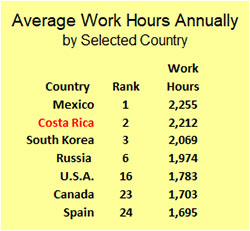 It has been previously noted that Costa Rica has undergone explosive population growth in the last 50 years (like 276% since 1960). One of the first things GG learned shortly after I began living here permanently was that the normal workweek is six-eight hour days.
It has been previously noted that Costa Rica has undergone explosive population growth in the last 50 years (like 276% since 1960). One of the first things GG learned shortly after I began living here permanently was that the normal workweek is six-eight hour days.
If you work 50 weeks (2 weeks vacation) at 40 hours per week, you will work 2000 hours per year. But the OECD (Organization for Economic Cooperation and Development) defines work hours as the total hours worked divided by the average number of people in employment per year. Using that definition, the data by country for selected countries is shown on the table to the left.
The data from recent studies shows that Costa Rica's work hours per employee averages 2,212 per year, second only to Mexico. The average work time in Costa Rica is 24% greater than in the U.S. and 30% greater than in Canada.
So much for the lazy Latinos theory.
¡Pura Vida!
 GGC Publications Group is the parent organization that publishes the Golden Gringo Chronicles as well as a number of books and paraphernalia related to the Chronicles and Costa Rica.
GGC Publications Group is the parent organization that publishes the Golden Gringo Chronicles as well as a number of books and paraphernalia related to the Chronicles and Costa Rica. The page is called GGC Publications Page - Products and has 3 sections:

 This section of the GGC Publications Page consists of descriptions of the following books published by GGC Publications:
This section of the GGC Publications Page consists of descriptions of the following books published by GGC Publications:Or go here for all of them: GGC Publications Page - Products Section I
Section II: Recommended Inspirational Books - Life Changing Stories

 S.O.B.E.R. - How the Acronyms of AA Got One Drunk Sober - by Ian Asotte (description and details HERE)
S.O.B.E.R. - How the Acronyms of AA Got One Drunk Sober - by Ian Asotte (description and details HERE)
◄To Eternal Happiness - by Abelardo Garcia, Jr. (see description and details HERE)
A Woman Awakens: Life, AfterLife - by Jan Hart (see description HERE)►
Or go here to see all of them: GGC Publications Page - Products Section II
Section III: T-Shirts and Coffee Mugs All About Costa Rica and the Chronicles
In addition, GGC Publications Group now also offers t-shirts and coffee mugs that are related to the Golden Gringo Chronicles with Costa Rican themes, to wit:

 T-Shirts: a. Golden Gringo Chronicles with Logo, b. Official Golden Gringo with Monkey on Banana Hammock, c. ¡Quepo en Quepos! ("I Fit In Quepos!") with Photo of Quepos, d. Wanna Monkey Around - Come on Down! with Photo of White Face Monkey and e. It's OK to be Slothful with photo of Three-Toed Sloth.
T-Shirts: a. Golden Gringo Chronicles with Logo, b. Official Golden Gringo with Monkey on Banana Hammock, c. ¡Quepo en Quepos! ("I Fit In Quepos!") with Photo of Quepos, d. Wanna Monkey Around - Come on Down! with Photo of White Face Monkey and e. It's OK to be Slothful with photo of Three-Toed Sloth.
Coffee Mugs: a. Golden Gringo, b. Wanna Monkey Around?, c. OK to be Slothful
Technically, Costa Rica is too far south to have hurricanes. Most of the country is between nine and ten degrees latitude while hurricane activity almost always occurs above ten degrees. But tell that to the people in northern Costa Rica who experienced the hardships caused by the tail end of Hurricane Otto that passed through southeastern Nicaragua and then across the northern regions of Costa Rica accumulating great amounts of rain and wind damage. A second storm, tropical storm Nate, passed through southern and eastern Costa Rica last year. A personal experience with Nate is the subject of our first feature article below.
This past month we had little in the way of major quakes (there were a few rumbles), volcano eruptions (continuing minor eruptions in the central mountain at places like Turrialba and Poas) nor inundations but we always are under a threat for major storms. Living in Florida wasn't much different, except for the earthquakes which were virtually non-existant, and I thought in might be a good change of pace to post a few of the humorous cartoons about Florida that deal with hurricanes, to wit:
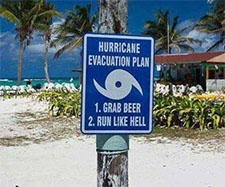 |
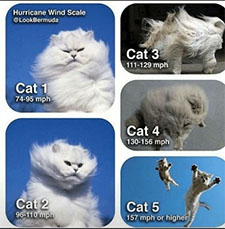 |
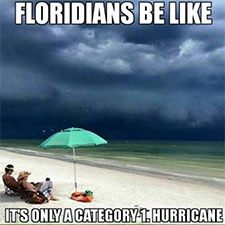 |
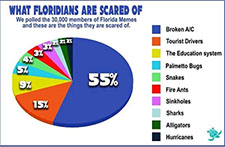 |
 |
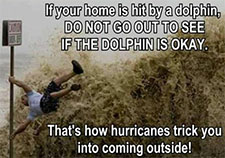 |
¡Pura Vida!
Check Out Recent Earthquakes Around the World Posted by the U.S. Geodetic Survey: Recent Quakes |
Search the Golden Gringo Chronicles Archives for Topics That Interest You
You can use our Archives to search for anything that has been written in more than 220 feature articles of the Golden Gringo Chronicles plus find Broken News items and ROMEO restaurant reviews. Enter your topic or item to search in the Google Search Routine below and follow the links offered from the search results. Suggestion: Enter only a simple, precise and unique as possible keyword or two in order to narrow the number of references retrieved:
Readers: Our publication is open to suggestions regarding future articles and will accept pieces written by others but we reserve the right to decline anything that the editorial staff (that's GG) thinks is inappropriate for this format. Send proposals, comments, suggestions, ideas, meaningless statements and jocular observations concerning the Chronicles to GG here: gg@goldengringo.com.
Jan Hart is a watercolor specialist and teacher as well as an author. She lives in an idyllic mountain top retreat that overlooks the city of San Isidro, Costa Rica, about 75 km or 45 miles southeast of Quepos. Her property truly offers a breathtaking view of some of the most beautiful and spectacular valleys and mountains in the southern part of the country.
This article is about her experience with the horrendous tropical storm (tormenta in Spanish) called Nate that passed through the country in October last year. The story relates the considerable effort she had to expend in the recovery process from Nate. This storm moved into Costa Rica from the Caribbean and literally inundated the country in many places, particularly in the southern and eastern provinces. In a mountainous terrain, torrential rainfalls inevitably produce flooding and also, particularly in the hilly areas, you can expect landslides similar and sometimes worse than similar California experiences.
But let's let Jan tell the story in her own words:
Rebuilding is in Process
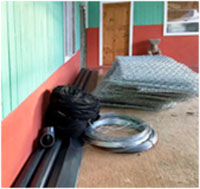 The rebuilding of the wrecked wall project became official in my mind when I turned my car into my carport and saw the pile of supplies: a stack of collapsed gaviones (galvanized steel wire cages that would be filled with rocks and the cages then used to build a retaining wall), hard black plastic tubing, a roll of black hardware cloth, several rectangular steel purlins and a huge roll of wire.
The rebuilding of the wrecked wall project became official in my mind when I turned my car into my carport and saw the pile of supplies: a stack of collapsed gaviones (galvanized steel wire cages that would be filled with rocks and the cages then used to build a retaining wall), hard black plastic tubing, a roll of black hardware cloth, several rectangular steel purlins and a huge roll of wire.
Cautioning myself to be careful not to get my hopes up, I felt the first flutter of anticipation in two and a half months since the devastating landslide that took most of my front yard and threatened the house, Frank’s house and the Infinity deck. I answered my cell phone ring to hear Billy, my Tico friend and neighbor ask how I liked the delivery. Of course I was elated and eager – and it seemed that he was too. We would be beginning in the morning at six and Billy would be the facilitator.
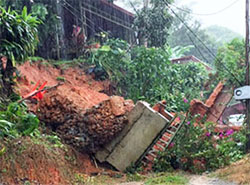 Showered and ready by five, I walked down with the aid of my walking sticks to greet Billy and the rest of the project crew. As I carefully maneuvered the slope, I thought back through the time since Tropical Storm Nate pounded the country with wind and heavy drenching rain and was proclaimed the worst devastation Costa Rica had endured in living memory. The unrelenting rain and wind caused power outages, heavy flooding and hundreds of landslides. We who lived in the southern zone were physically cut off from the rest of the country to the north. The main roads and a primary bridge had been destroyed.
Showered and ready by five, I walked down with the aid of my walking sticks to greet Billy and the rest of the project crew. As I carefully maneuvered the slope, I thought back through the time since Tropical Storm Nate pounded the country with wind and heavy drenching rain and was proclaimed the worst devastation Costa Rica had endured in living memory. The unrelenting rain and wind caused power outages, heavy flooding and hundreds of landslides. We who lived in the southern zone were physically cut off from the rest of the country to the north. The main roads and a primary bridge had been destroyed.
We knew that this ambitious country would work feverishly to repair, but it would be awhile. After the shock and initial fear gave me some time to breathe, and after Billy, my Tico friend, neighbor and ‘like a son’ helped by locating a backhoe and dump truck to remove the huge pile of concrete, rocks and earth from my neighbors’ access road, I talked with my son, Tim about what to do.
The Morning of October 5, 2017
In the nine years I had lived in San Isidro de El General, the slope in front of the house had failed three times due to poor and makeshift solutions to the too-steep location. We knew we had to find a permanent solution. The three of us – Billy, Tim and I researched, talked with experts and finally agreed upon a good plan to secure the slope and property. And it was about to be implemented. I had waited for two and a half months for the rainy season to pass. The dry season was here and we were ready!
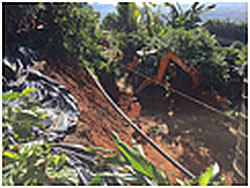 |
| Forming the Earth with the Backhoe |
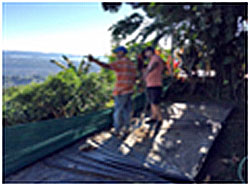 |
| Measuring, Planning and Planning More |
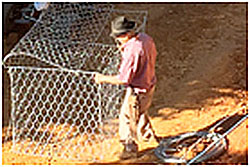 |
| Building Gaviones |
The first step was to make the area ready for rebuilding, again using the backhoe. That followed lots of measuring and planning and discussing.
Using the Tico methods for measuring the site elevations, Billy and Ronny, the project foreman made their calculations and designations. Our building blocks would be the standard steel wire gaviones that were used throughout the country for freeway embankments and retaining walls.
Since each gavión measured 2 meters long, 1 meter high and 1 meter wide, the area to prepare was about 36’ long and sloped up to a height of twenty feet at about a 60 degree angle. After talking with engineers, we decided that the base level would begin about 18” below grade both for stability and the estimated height.
And we decided that some of the base level gaviones would be placed in a perpendicular rotation extending further under the slope for greater stability and strength. They were the ones on each end as well as two side by side in the center. This decision meant digging mini caves for those oriented differently. There would be a total of 38 gaviones – quite a project. Most of Saturday morning was used for the digging prep work.
The actual rebuilding began at 6 a.m. on Monday morning, the week before Christmas. Momentum was set with a varying number of workers that ranged in age from 7 – 75 and who were all neighbors or related except for Billy. Billy was the man in charge – negotiator, overseer, Project manager. With the huge help of my son Tim and daughter-in-law Shelby, I gave Billy the money that he estimated as he would be in charge of it all. My job was to observe from above, photograph, and to bring large bottles of soft drinks to the working crew twice a day. Additionally, I was the cheerleader – complimenting and approving the work.
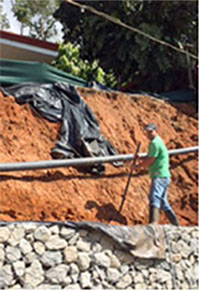 |
| Billy at Work |
Behind the scenes, Billy and I would discuss any related issues privately. For the crew, Ronny was in charge. He was the gavión expert with quite a lot of experience. Billy had said from the outset that it was crucial to have Ronny in charge not only because of his expertise but most importantly because of his position in the family. As a family member he would make sure that the project was handled well and would ensure that the family was engaged and approving.
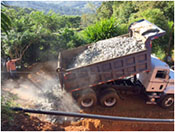 The work began with the first gavión being wired together and placed in the ground. As more gaviones were wired together, a huge dump truck made its first delivery of rocks – mostly smoothed and varying in size from 3” to 10” in diameter. Then the tedious and very repetitive business of picking up the rocks, each by hand – and placing them into a waiting gavión. Different members of the extended family contributed their efforts and these included grand children and even Grandfather Antonio and Grandmother, Virginia.
The work began with the first gavión being wired together and placed in the ground. As more gaviones were wired together, a huge dump truck made its first delivery of rocks – mostly smoothed and varying in size from 3” to 10” in diameter. Then the tedious and very repetitive business of picking up the rocks, each by hand – and placing them into a waiting gavión. Different members of the extended family contributed their efforts and these included grand children and even Grandfather Antonio and Grandmother, Virginia.
Concurrently, and while attention was focused upon one gavión filling, Ronny would carefully string wire across the length and breadth of each gavión to keep it braced against the weight of the rocks. Additionally, long steel purlins were wired to the face of the gaviones to further reinforce the front or cara of the placed rocks. After a gavión was filled, the top would be wired closed and the purlins would be removed to be ready for the next placement. And so it went, gavión by gavión.
Originally, when Billy and I discussed how the wall would be rebuilt, I had expressed a few reservations about hiring Ronny and the rest of the family that lived below. Billy was quite sure they were perfect choices, however – primarily because the wall bordered their property. They were in the one position to make or break the project. I looked back over my almost 9 years in Costa Rica and remembered a few difficult encounters that included suspicions of robbery by one of the grandsons. Billy, too had some reservations about one of the family members. Still, the lesson in amiable living with one’s Tico neighbors was in learning how to let go of a misgiving no matter how suspicion fortified it happened to be. We both would focus on positive aspects of each family member. And the person in question had a great smile! Costa Rica was, after all Pura Vida!
So the week before Christmas was consumed with work on the gaviones, beginning at six a.m. and ending around 5 p.m. The hours were punctuated with lively exchanges, family member visits, comings and goings of other family members along with dump trucks filled with rocks and quite a succession of barking dogs. By Christmas Eve, work was stopped mid-way across level three with promises of more workers and efforts on December 26.
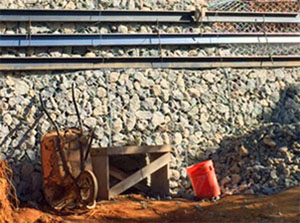 As I drove back to my house after delivering various baskets of Christmas goodies to several families in the neighborhood that included my workers below, this view of the project in process caught my eye. There was a lovely still life arrangement of the various tools and equipment all against the backdrop of the partially finished wall. The haphazard placement of the wheelbarrow, makeshift stool and a leaning bucket was perfect next to the remaining pile of rocks.
As I drove back to my house after delivering various baskets of Christmas goodies to several families in the neighborhood that included my workers below, this view of the project in process caught my eye. There was a lovely still life arrangement of the various tools and equipment all against the backdrop of the partially finished wall. The haphazard placement of the wheelbarrow, makeshift stool and a leaning bucket was perfect next to the remaining pile of rocks.
I thought to myself that this was a perfect Holiday Christmas card. It represents a pause; a moment in time. There is a promise of much to do ahead but for now – there is time to appreciate the simple beauty of what has already been accomplished.
Perfect.
___ ___ ___
Thanks Jan for another fine story.
Jan Hart is a friend and fellow writer and a member of the Quepos-Manuel Antonio Writers Group. She has published The Watercolor Artist's Guide to Exceptional Color and also an inspirational book featured on the GGC Publications page which you can read about here: A Women Awakens - Life, After Life
Also check out her website at www.janhart.com for a video of her home and the incredible vista of the surrounding area.
¡Solo Bueno!
 Could this be a new vinyl textured wallpaper?
Could this be a new vinyl textured wallpaper?
Perhaps it's a picture from the space probe Voyager as it approached one of Pluto's moons?
(The digit at the top is not the finger of God and not part of the mystery, it belongs to GG who still has difficulty
keeping himself out of some pictures)
Answer in What's-in-a-Word section below.
¡Pura Vida!
 The idea behind Golden Gringo University is to present educational topics of wide interest to expats who have recently moved to Costa Rica or to future expats who might be thinking of moving here or to those who simply visit here frequently. Our goal and objective is to provide accurate information that readers will find helpful in their efforts to be a good expat resident or visitor in Costa Rica. In Part 1 of our three part series, last month we reviewed the the country's history, physical size and population, the Costa Rican constitution, government structure and stability and the economy.
The idea behind Golden Gringo University is to present educational topics of wide interest to expats who have recently moved to Costa Rica or to future expats who might be thinking of moving here or to those who simply visit here frequently. Our goal and objective is to provide accurate information that readers will find helpful in their efforts to be a good expat resident or visitor in Costa Rica. In Part 1 of our three part series, last month we reviewed the the country's history, physical size and population, the Costa Rican constitution, government structure and stability and the economy.
In Part 2 this month we will continue our discussion about encountering cultural differences on a more personal or daily level including language and education, money and banking, names and surnames, addresses and street names.
Language & Education
While there is retention of some Native American languages in a few of the remote areas of Costa Rica (Bri-Bri for example), the predominant language here as in most of Central and South America is Spanish.
This is a result of some 300 years of Spanish occupation that occurred from approximately 1502 to 1821. It is not only the common language but also the official language of Costa Rica according to the constitution. Although it is not required that public employees or commercial services speak English, that tongue is the second most frequently heard and used language in the country. Even though not required by law, banks, business enterprises and government offices will go out of their way to find someone who speaks English to serve you if that's what you need.
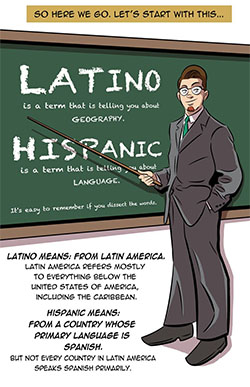 Direct translation from Spanish to English and vice-versa is often not easy and occasionally not possible. In many cases the word that looks familiar to an English speaker may mean something completely different. Take
embarazado for example; it sounds like being embarrassed but in the most common translation it means you're pregnant. In other situations a word becomes quite flexible: take la esposa for example; it can mean "wife" but it's also true that las esposas can mean "handcuffs" (hold the sexist jokes please). There is also an extensive list of Spanish tongue twisters available to you such as "¿Usted no nada nada? No, no traje traje." ("You don't swim at all? No, I didn't bring a (swim) suit").
Direct translation from Spanish to English and vice-versa is often not easy and occasionally not possible. In many cases the word that looks familiar to an English speaker may mean something completely different. Take
embarazado for example; it sounds like being embarrassed but in the most common translation it means you're pregnant. In other situations a word becomes quite flexible: take la esposa for example; it can mean "wife" but it's also true that las esposas can mean "handcuffs" (hold the sexist jokes please). There is also an extensive list of Spanish tongue twisters available to you such as "¿Usted no nada nada? No, no traje traje." ("You don't swim at all? No, I didn't bring a (swim) suit").
The flexibility and subtleness of the language is beyond the scope of this writing, so some form of language training, a least for the basics, is strongly suggested for all who come here more than once. There are many competent schools and private tutors available in virtually all parts of the country and just trying to use the Spanish language to the best of your ability will bring you a host of Tico friends. As a Canadian friend of mine who is quite fluent in Spanish says: "You don't have to speak Spanish to live here - but you will miss a lot!"
Costa Ricans place a high value on education. Perhaps this is best described by quoting a report recently published that said: "The Costa Rica education system is ranked 20th in the "Global Competitiveness Report 2013–14", and is described as being of "high quality". The literacy rate in Costa Rica is 94.9%. It is 2 points over the average for Latin American and Caribbean countries."
There is a strong, free public education system (but there can be and usually are significant fees for uniforms, books, and miscellaneous items) through primary grades and high school. There also is a strong private education system available in most of the sizable populated communities (Quepos has several private schools for example). Education, whether public or private through high school is compulsory. There are also many pre-school programs throughout the country as well as six public universities and over a dozen private universities. One of the interesting aspects of the pubic universities is that no two may offer the same degree program so that where you go is often dictated by what you want to learn and become.
For more details on the Costa Rican education system go HERE.
Money and Banking
The primary currency in Costa Rica is the Colón (plural Colónes), which of course is also the Spanish name for Columbus. The symbol for the Colón is ₡, which differs from the U.S. cent (¢) as it is a capital C with two diagonal lines versus a lower case c with one diagonal line for the U.S. penny.
 Colón coins come in six denominations, 5, 10, 25, 50, 100 and 500. The first two are made of tin or aluminum while the last four are made of a brass alloy. Each denomination is a different size. The brass coins are bigger, thicker and heavier than, for example, the U.S. penny, nickel, dime and quarter and therefore weigh down your pocket considerably more if you have lots of them.
Colón coins come in six denominations, 5, 10, 25, 50, 100 and 500. The first two are made of tin or aluminum while the last four are made of a brass alloy. Each denomination is a different size. The brass coins are bigger, thicker and heavier than, for example, the U.S. penny, nickel, dime and quarter and therefore weigh down your pocket considerably more if you have lots of them.
 Colón bills come in six denominations: 1,000, 2,000, 5,000, 10,000, 20,000 and 50,000. The 20k and 50k notes are fairly new issues with the 20's starting to become more popular while the 50's are still uncommon in general circulation. The six bills are also of different sizes and considerably different colors, although the new 20,000 note is just close enough in hue to the 1,000 that sometimes makes it troubling. The very common 1,000 is also made of a different material, kind of a vinyl plastic, and can be difficult to handle as they always want to slip away from you and don't stack well. A 1,000 bill is often referred on the street to as a "rojo" (red).
Colón bills come in six denominations: 1,000, 2,000, 5,000, 10,000, 20,000 and 50,000. The 20k and 50k notes are fairly new issues with the 20's starting to become more popular while the 50's are still uncommon in general circulation. The six bills are also of different sizes and considerably different colors, although the new 20,000 note is just close enough in hue to the 1,000 that sometimes makes it troubling. The very common 1,000 is also made of a different material, kind of a vinyl plastic, and can be difficult to handle as they always want to slip away from you and don't stack well. A 1,000 bill is often referred on the street to as a "rojo" (red).
U.S. Dollars of most denominations are accepted virtually everywhere but in many places $50 and $100 bills are rejected due to merchant's past bad experiences with counterfeit bills that occasionally have flooded Central America. As for U.S. coins neither banks nor businesses nor government offices, virtually no one, accepts them. When you use dollars to buy, more than likely you will receive your change in Colónes, probably at an exchange rate favorable to the merchant (like ₡500 to the dollar).
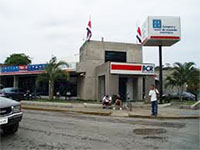 |
| BCR - Quepos Branch |
There are two major national banks which are chartered by the government; Banco National (BN) and Banco de Costa Rica (BCR). There is also a wide variety of private banks that provide full banking services including but not limited to Promerica, Banco Popular, Scotiabank and others. There are three banks that have an agreement with the U.S. Social Security Administration, BN, BCR and Scotiabank that permits direct deposit of social security payments. In addition to banks there are several different "cooperativos" (Coopealianza for example) that function as Credit Unions.
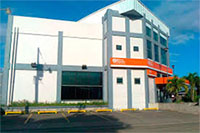 |
| Banco Popular - Quepos |
ATM's are called Cajeros Automáticos (automatic cashiers) here. Most banks will provide currency at the prevailing central bank exchange rate and normally will accept foreign debit and credit cards. However which ones that are accepted depends on the foreign issuer of the card and the agreement they may have with the local banks. There can also be a daily limit (often $100 or $200) for dollar withdrawals from the ATM. You can usually get a greater amount, limited only by the underlying account balance, if you request an advance on the card through the tellers inside the bank (there may be a fee involved). Most bank ATM's that dispense dollars usually do so only in $20 units, not $1, $5, $10, $50 or $100.
The CRC/$ exchange rate at this writing is quoted as 568/575. This means to buy Colónes by selling dollars you will receive (at the bank or other reputable exchange office) 568 Colónes for each dollar sold. On the other hand, if you want to buy dollars using Colónes you will have to provide 575 Colónes for each dollar you buy.
For several years the exchange rate hovered around 500 and mental conversion was easy; multiply the Colónes by 2 and eliminate the three zeros from the number; to wit, a 1,000 Colón note x 2 = 2,000 cut the zeros and you have $2. In recent years the Colón exchange rate has drifted upward making quick arithmetic more difficult (if you're really good at arithmetic, you can subtract 15% or multiply by .85 from the example above - $2 less 15% = $1.70 or .85 x $2 is very close) but that's why pocket calculators were invented. In many cases a merchant will post the price in both currencies (most likely at his favored exchange rate).
GG has settled into a banking and money strategy that minimizes the use of dollars (I'm being generous to myself here for calling it a strategy). I have a BCR dollar account which gets a direct deposit of my Social Security check monthly in dollars and which is usually enough for my daily and monthly fixed expenses. I pull Colónes from that account as needed at the prevailing bank rate. The only thing I usually pay in dollars is my rent. Doing that transaction in dollars works out to my landlord's benefit as, over the time that I've been here the Colón/$ exchange rate has increased about 15% in favor of the dollar (500 to 575). This may be part of the reason he has not sought an increase in rent during that time - I'm sure my stunning personality is the other reason - yuk, yuk.
I also maintain a stateside account in which I get a direct deposit of a small pension. That account is good for electronic payments or transfers in the U.S. and provides a safety backup for unexpected situations (see Banking Scam above). That account is also used as my "mad money" in order to support the periodic travel wanderings of the Golden Gringo.
Names and Surnames
It's delightful to discover that many of the first names I thought were relegated to under-use in my native land still prevail in Costa Rica. Just in my neighborhood alone there is a Marvin and an Alvin, a Rudy and a Hortensia. There are also lots of biblical names such as Jesús (hay-soos not Jeezus), Manuel (Emmanuel), David (dah-veed - the most common male first name used in Costa Rica), Gabriel, Josue (ho-schway and often deemed equivalent to José). The top two names for girls in Costa Rica are Vanessa and Pamela according to published sources. But there is a wide variety of names for both sexes and just as you think you've heard them all another different and interesting one will pop up. My landlord's son just named his first born, a daughter, Valentina. How's that for a romantic name?
 Full surnames (in Spanish a surname is "el apellido") are constructed from the names of both parents. For example, a fellow named David with a father whose family name was Madrigal but whose mother's family name was Segura would have the full name of David Madrigal Segura for official records and documents. In modern use he would likely drop the Segura to go by David Madrigal or, alternatively, go by David Madrigal S. but all three names are important to him for formal processes. It is important to realize the second name is not a "middle" name but is instead the primary surname.
Full surnames (in Spanish a surname is "el apellido") are constructed from the names of both parents. For example, a fellow named David with a father whose family name was Madrigal but whose mother's family name was Segura would have the full name of David Madrigal Segura for official records and documents. In modern use he would likely drop the Segura to go by David Madrigal or, alternatively, go by David Madrigal S. but all three names are important to him for formal processes. It is important to realize the second name is not a "middle" name but is instead the primary surname.
You might as well get used to some people and organizations here referring to you by your middle name thinking it's a surname. My health card and driver's license both are named Normand Robert Arthur and sometimes I get addressed as "Robert Arthur" as if it were my last names. I chuckle because it reminds me of how my mom used to call me when I was a naughty boy - "Robert Arthur!". When I was good, it was "Bobby".
Addresses and Street Names
Street addresses in Costa Rica have come a long way, slowly. It has been previously noted above that the population has grown dramatically in recent decades and the corresponding growth of physical places has made it more important than ever that the address system modernize itself.
San José, understandably because of its size and complexity, has been in the forefront of developing a true geographical grid. Within the city limits the reported population is about 350,000 but the entire province is listed at 1.4 million. Add to that the contiguous provinces of Heredia and Alejuela and the total expands to 2.7 million and much of that is located in what is called the "Central Valley", roughly a 50 km radius of the center of San José which is estimated to contain nearly 70% of the country's population.
 San José is already divided by streets and avenues. The streets run north and south with the center being Calle 0 (or Central Street and located three blocks west of Teatro Nacional). Streets west of Calle 0 run evenly, Calle 2, 4, 6 etc. Streets running east of Calle 0 run in odd numbers; Calle 1, 3, 5 etc.
San José is already divided by streets and avenues. The streets run north and south with the center being Calle 0 (or Central Street and located three blocks west of Teatro Nacional). Streets west of Calle 0 run evenly, Calle 2, 4, 6 etc. Streets running east of Calle 0 run in odd numbers; Calle 1, 3, 5 etc.
The avenues run perpendicular to the streets with Avenida 0, also known as Avenida Central, passing near the Teatro Nacional. Avenidas running north do so in odd numbers; Avenido 1, 3, 5 etc. and those running south use even numbers; Avenida 2, 4, 6 etc.
Even though that street grid is sensibly numbered, most people including taxis still resort to their old world habit and rely on landmarks rather than addresses or even intersections. Tell a taxi driver you want to go to Fifth Street and Second Avenue (or even Calle Cinco and Avenida Secundo) and he's highly likely to look at you and say: "¿Perdon amigo?". Tell the driver you want to go to the CAJA Building and zip, bang, you're there. Supposedly, businesses, offices and residences have now also gotten numbers for addresses but don't bet on seeing those numbers prominently displayed on the locations quite yet.
For towns like Quepos it's still a matter of navigating by landmarks. GG offered a street naming protocol at one point (like in 2010) but the city has yet seen fit not to adopt it. See that plan HERE.
This ends Part 2 of our series on understanding Costa Rican culture. In Part 3, the final part next month, we will review food & markets, music, religion and sports. Stay tuned.
| Note: The information given in this section is offered as news information only and does not indicate GGC confirmation or denial of the accuracy of the treatment or a recommendation to pursue it, nor can we or do we guarantee the efficacy of the results nor validity of the conclusions proffered.
(How's that for a disclaimer?) |
Not a great deal of earth-shattering new information on the health front this month. One story posted by the press involved Costa Rican surgeons removing a 34 kilo ovarian tumor from a lady who lives in the Tibás, suburb of San José. Holy rupture Batman, that's almost 75 lbs! And the local medical community thinks it might be a world record weight. The patient weighed 123 kilos (270 lbs) before the surgery and after the procedure her weight was measured at 89 kg (196 lbs).
¡Pura Vida!
 |
Answer to Que Es Eso?
 |
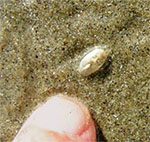 |
These are crab tracks made by a cute little devil one finds on Manuel Antonio beach.
I'm not sure if the crab pictured in the lower photo left is the actual type of crab that made the kind of tracks I'm used to seeing on the beach but it's close.
 The track marking is prominent at low tides. This particular type of crab does not leave holes or sand balls like some do (pictured at right). It looks like they move on very short legs, more like a centipede, and just under the surface of the sand.
The track marking is prominent at low tides. This particular type of crab does not leave holes or sand balls like some do (pictured at right). It looks like they move on very short legs, more like a centipede, and just under the surface of the sand.
Thanks guys for decorating the beach.
Alvarado
Alvarado, the last name of our two remaining presidential candidates is a geographical or habitational name originating from one of several places called Alvarado, meaning "whitened place". Many came from Alvarado in Badajoz Province, Spain. Alvarado means "dweller near a white hill or on dry land."
Sakura Fusion- Manuel Antonio
Location: Top of Manuel Antonio hill in the strip mall near Promerica Plaza, across the street from Cafe Milagro
Hours: Monday thru Sunday lunch and dinner.
Contact: Tel: 2774 0295, no website as of this writing.
Reviewing ROMEOS: Alma L., Anita M., Bob N., Duston R., Jerry C., Joanne K., Kathleen K.
To Review Our Rating System and Procedure, go here: R.O.M.E.O. Rating System
This is a new restaurant in a small strip mall on top of Manuel Antonio across the street from Cafe Milagro. It's basically a small rectangular room with a deck on the back. Seating including two small tables inside is less than 30.
Although there is a narrow view of the pacific through the woods below, the view from the deck is basically the back of other buildings. The ROMEOS gave Sakura Fusion a composite score of 3.5 sloths out of 5 for ambiance.
The menu reflects the name of the restaurant, sushi plus a smattering of Thai dishes such as Pad Thai.
GG ordered a rice dish described as "Basil Rice with Shrimp". What arrived was something on the order of arroz cantonese, not many shrimp plus some pieces of pork and other seafood.
Others ordered a variety of sushi, sashimi and veggies dishes. Two orders were sent back, one for taste (pad thai) that was replaced with a lobster roll and one for burned noodles which was replaced with a new order. In general, the sushi got higher marks that the Thia offerings but one of the sushi dishes was described as grisly and and another as gummy.
Other remarks about this restaurant from the ROMEOs: "Veggie dishes were tasty", "Tico-Thai at best", "Disappointment!", Mango con Leche drink was good".
Composite food score from the ROMEOs was 2.6/5.0. |
 |
|---|---|
$$$.7 |
|
Value Index= 79
|
Service was adequate but not exceptional but the waiter tried to accommodate our needs. The composite score for service came in at 2.7/5.0. That gave a composite score for ambiance, food and service of 2.9
For my basil rice and a piña/papaya-in-water smoothie, the bill was ₡10,300 or a little over $18. Other bills came in as high as $35 for a selection of three sushi rolls. The composite score for cost came in at 3.7/5.0 making the value index 2.9/3.7x100=79, one of the lowest value indexes we've seen in recent years.
In all good conscience we cannot recommend Sakura Fusion at this time and hope that the inconsistency and problems we encountered were a result of the place being new; we'll try again later.
¡Pura Vida!
The Golden Gringo Chronicles is a free newsletter that is non-political, non-commercial and, hopefully, entertaining. By signing up you will receive an email each month around the first of the month giving you the links to the latest edition as well as to each individual feature and departmental section.
or Email me at gg@goldengringo.com, and see our Website at: www.goldengringo.com

To Contact GGC World Headquarters (yuk, yuk) to make comments, suggest topics or criticize my bad jokes, just send an email to: gg@goldengringo.com.
Unsubscribe from Golden Gringo Chronicles